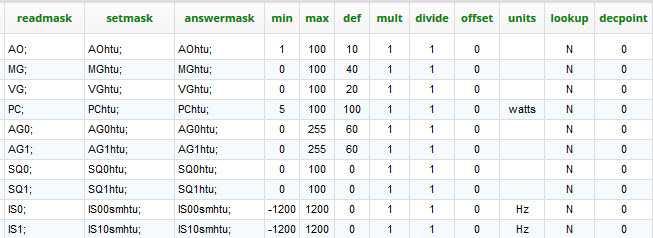4.4 piWebCAT - Database table - sliders See sliders configuration notes timing.disable
The configuration of sliders follows the same principles as for buttons.
The difference is that all the client and server data is in one large table
(where as buttons referenced table catcodes for server functions)
So - at startup, piWebCAT extracts part of the data from sliders to store on the client.
The server, on receipt of a command, reads sliders from the database for server functions.
The client held data from the sliders table includes data for formatting of the numeric text displays.
Slider positions are set when read from the radio at startup and change on slider movement.
slider fields:
- rig The current radio - drop down selector (from radios table)
Must have same spelling through the tables. - description Descriptive text- no function
- caption The caption to the left of the slider.
Note that this only applies to the central column of sliders with no adjacent
on/off button with identifying caption. (suggest set to 'nocap' if not used)
- sliderno The sliders's unique, fixed, numeric identifier. See: Button and slider numbering
- active Y = slider active, N = slider inactive, S = sync (repetetive updates from rig)
L = sync with alternative appearance, - code 3 or 4 upper case characters. This links a slider movement action on the client
to its action processes on the server. It is transmitted to the server with data (jobdata)
See below for more explanation. - vx vx = V, X or U. Client field that controls storage of latest setting for each VFO.
vx is set to V for dual receiver settings for the radios stores a different value per receiver. - abx A or B if there is pair of entries one for each VFO eg: DNR level, RF gain
X if A or B not relevant. (eg: RF power level, mic gain etc) See: vx and abx - readbytes The number of bytes in a read command (= no of chars in readmask)
- setbytes The number of bytes in a set command (= no of chars in setmask)
- answerbytes The number of bytes in an answer (= no of chars in answermask)
- readmask The character pattern of the read command, see Command masks
- setmask The character pattern of the set command. see Command masks
- answermask The character pattern of the answer. see Command masks
- min The minumum of the CAT data Ie before scaling etc)
- max The maximum value of the CAT data.
min and max ensure that the range of the sent CAT value spans the
limits of the slider and that the slider response to radio initiated change
also fits the range, - def Default value - set by the associated reset button (not available on all sliders)
- mult Multiplier to scale CAT value for display.
- divide Divider to scale CAT value for display.
eg: use (CAT * 100) / 255 to scale 0-255 to 0 - 100
(Multiply first then divide because we are working in integers). - offset Offset applied to display value. eg: offset = -50 scales 0 -100 to -50 to +50.
- units Units after displayed value eg: Hz kHz etc
- lookup If lookup = Y then displayed value is taken from lookup table entries with matching code.
Lookup uses the CAT value after scaling (if any).
If lookup = M then displayvalue from lookup table entry with matching code
and lookup table mode field = current operating mode ( eg: USB, LSB etc).
For lookup = M, lookup table mode must be the mode button's caption -
ie: LSB, USB, CW etc (NOT SSB) See Lookup table .
- decpoint Add decimal point = dec places. eg: decpoint = 3 for 3000Hz to 3.000kHz.
Below is a screen dump of the slider table in piWebCAT editor
It is split into left and right parts with readmask in both for visual alignment.


Example, IF shift

Yaesu CAT manual

This is a slider without an on/off button but with a reset-to default button.
caption = "IF shift" for the label
code = "IFSH" (or whatever you choose) It is loaded to the client at startup and transmitted
to the server as a linking identifier.
sliderno is fixed for this slider, irrespective of its function and must not be changed.
abx = A or B.Current VFO selection A or B is held on the client and sent to the server.
The server can then send the correct ( A or B) CAT message to the radio.
readbytes or setbytes and readmask or setmask define the message to the radio.
answrerbytes is essential so that the server code knows how many returned bytes to wait for.
answermask is is used to decode the character string response for the radio.
min. max, multi, divide, offset, units and lookup define the presentation of the data, ie: -276Hz
The CAT manual specifies the data in P2 P3 P3 P3 P3 eg: - 0276
P2 is the sign (- or +). This is represented by lower case 's; in the mask.